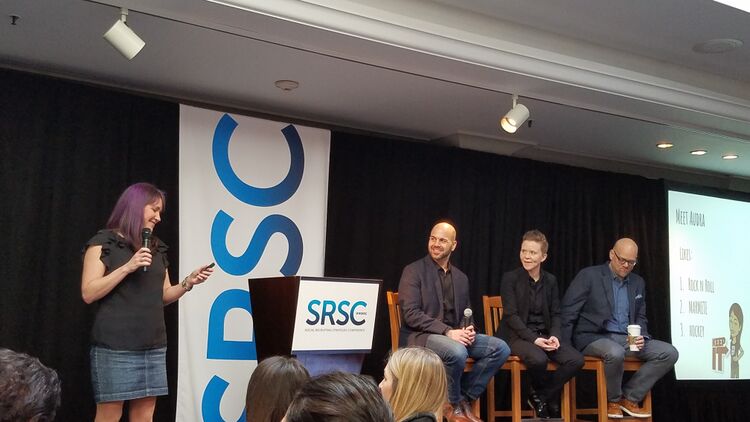Social Recruiting: Careers Channels or Corporate Channels?
February 14, 2018 by Lori Sylvia, Founder and CEO, Rally Recruitment Marketing

Did you know that more than 3 billion people use social media? That’s 40% of the world’s population! A stat like that is why more talent acquisition teams are looking to social recruiting to try to reach candidates.
While we know active and passive candidates are using social media, there’s so much we still need to learn about how to attract and engage talent effectively on Facebook, Twitter, Instagram, Snapchat, etc.
The Social Recruiting Strategies Conference (#SRSC) is held twice a year to offer fresh ideas from practitioners who are a bit ahead of the pack in using social media. I had the opportunity to attend my first #SRSC last week in San Francisco. What I learned is that no one has social recruiting completely figured out, and I found that comforting.
In HR and TA there always seems to be a new strategy, a new technology or a new channel that suddenly becomes a buzzword, and we’re still trying to understand what it means to us when the next buzzword comes along. (At Rally, we like to break down buzzwords, so here’s our explanation of social recruiting for beginners.)
The fact that 3 billion people are using social media is a good enough reason for talent acquisition leaders to put more resources towards figuring out social recruiting. I often hear members of the Rally community say they started their Recruitment Marketing career by becoming responsible for sharing their company’s careers content and job opportunities through social. A question I always ask is:
Do you have dedicated social channels for careers, or are you sharing careers content on your company’s corporate channels?
At #SRSC, I was so excited to see this very question be the subject of a panel discussion. And I was even more excited to see two of our RallyRM Mentors – Audra Knight (@media2knight) and Lindsay Parks (@LParks2387) – on the panel! Joining Audra and Lindsay were Steven Kosakow (@eselkay) and James Ellis (@thewarfortalent).
I learned from the panelists that there isn’t one right answer to the big social recruiting question about “careers channels versus corporate channels.”
Here are my key takeaways from the panel:
- When deciding whether to have dedicated careers channels or use corporate social media channels, there are 5 main factors to consider: budget, time, team size, relationship with Marketing and legal constraints.
- The decision isn’t necessarily all or nothing. Some companies have one or two social channels like Facebook and LinkedIn that are managed by HR/TA, whereas Twitter and Instagram may be managed by Marketing.
- If you’re just getting started with owning a careers channel, it probably makes sense to manage the company’s LinkedIn page, since this channel is active with job seekers.
- Having a dedicated Twitter channel for careers can be a good idea if you exhibit at recruiting events and there’s a lot of Twitter activity before, during and after the event. Otherwise, the corporate channel could be overtaken by career fair tweets.
- If the Marketing team manages all the social channels and you’re just getting started with social recruiting, propose one careers post a week. Provide Marketing with an employee story talking about a successful customer project. Once the Marketing team sees the social engagement, be ready for them to ask what other employee stories you’ve got!
- One way to develop a careers following on corporate channels is by using a careers hashtag, such as #lifeat[company]. It’s also a great way to get employees engaged in sharing their experience at work with their social networks, which can help drive referrals.
- When sharing careers content, think about the candidate experience. A best practice is to include a call to action (CTA) that directs a candidate to a landing page that’s created specifically for that content and for that audience. For example, link to an employee story video, and then below the video or in a sidebar display a list of related jobs. One panelist recommended Unbounce as an affordable tool to create landing pages.
- If you’re using paid social ads, be careful that you don’t target people by age group.
- Using hashtags can be a great way to expand the reach of your employer brand on social media. But don’t feel that you have to jump on every hashtag bandwagon. Consider if the hashtag is a brand fit. (RallyRM Mentor Lindsay Parks gives great advice on this topic in her blog post on social recruiting calendar templates.)
- Creating a LinkedIn Showcase Page may not be right for your company if you’re still trying to build an audience for your main LinkedIn Company Profile.
- When you have a good piece of careers content, it’s perfectly fine to share the same post on all your social channels, especially if you’re pressed for time and short on resources. But make sure the target audience for that content is in each place! If your content is about a hackathon for engineers, it might not make sense to post to LinkedIn if that’s not where they hang out. Also, be mindful of the different requirements for social media image sizes.
The main message from the panelists: Don’t stress over social recruiting – just go for it! What do you really have to lose?
This blog post was originally published on Rally Recruitment Marketing.
Rally™ Recruitment Marketing is an online community forum where the best Recruitment Marketing ideas are learned and shared to educate and empower you to lead the future of talent acquisition. Rally with us at https://rallyrecruitmentmarketing.com.

